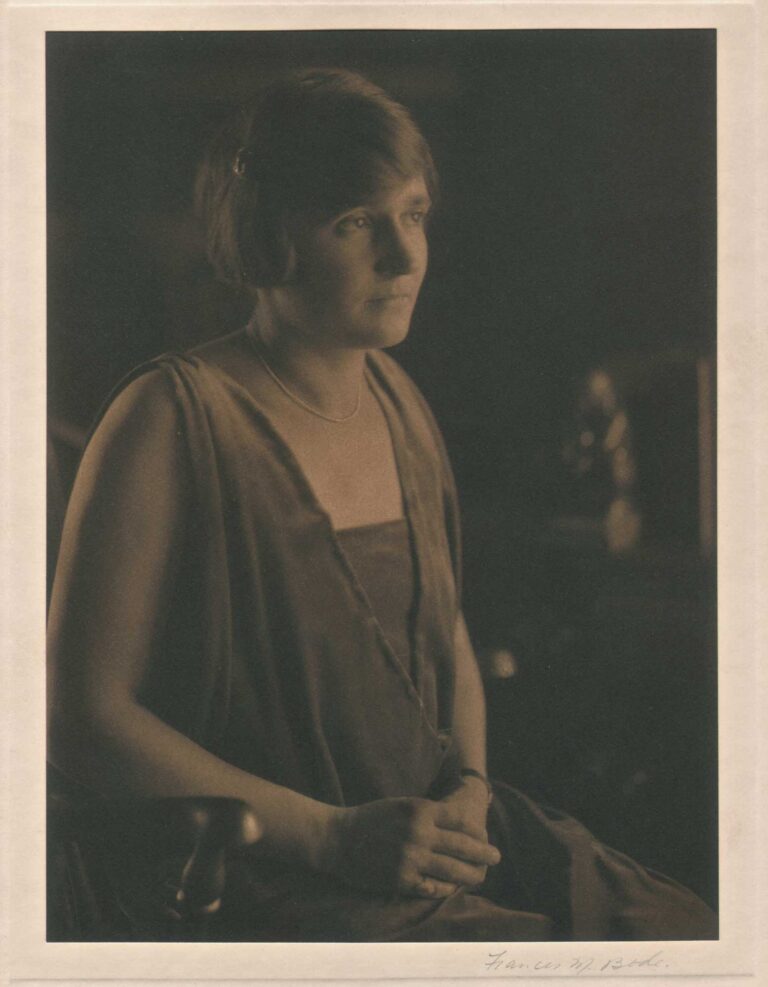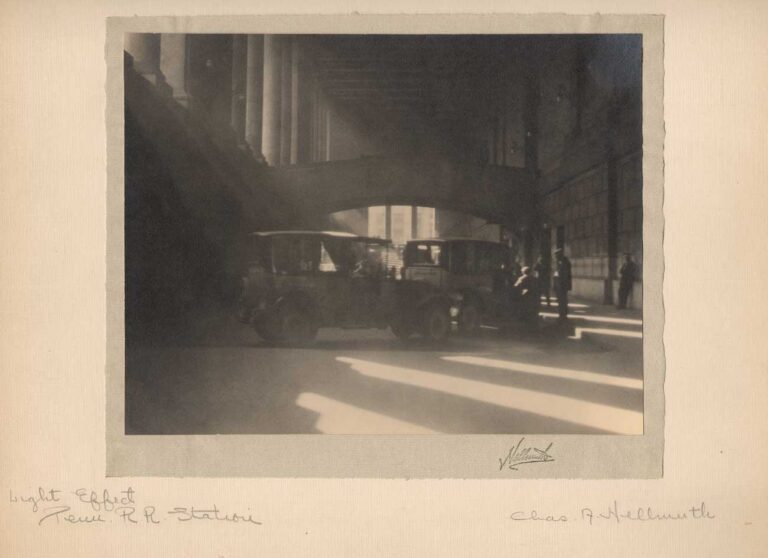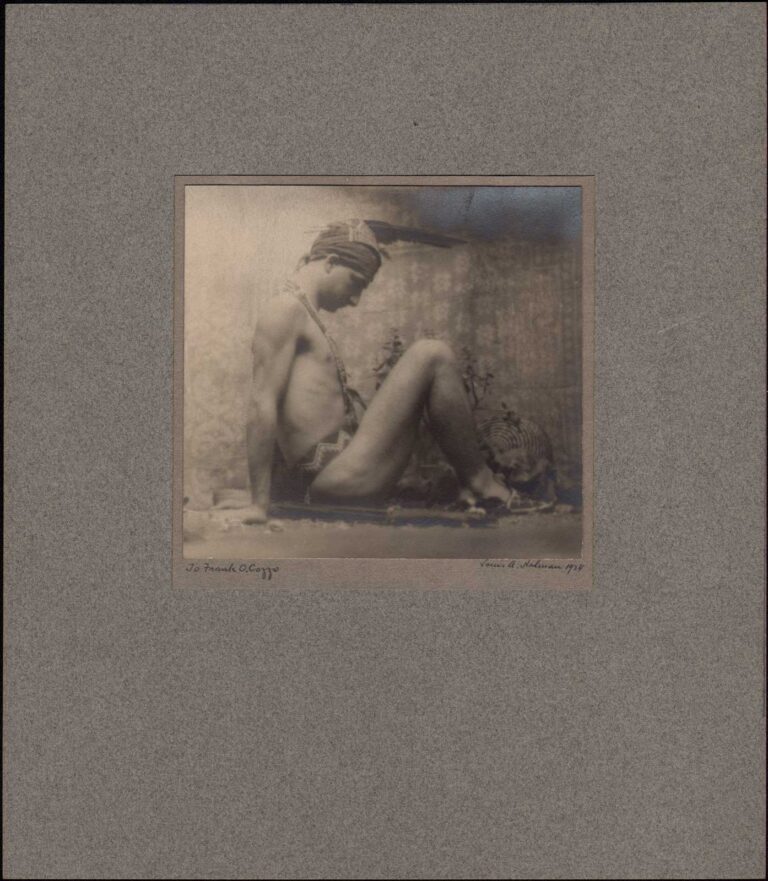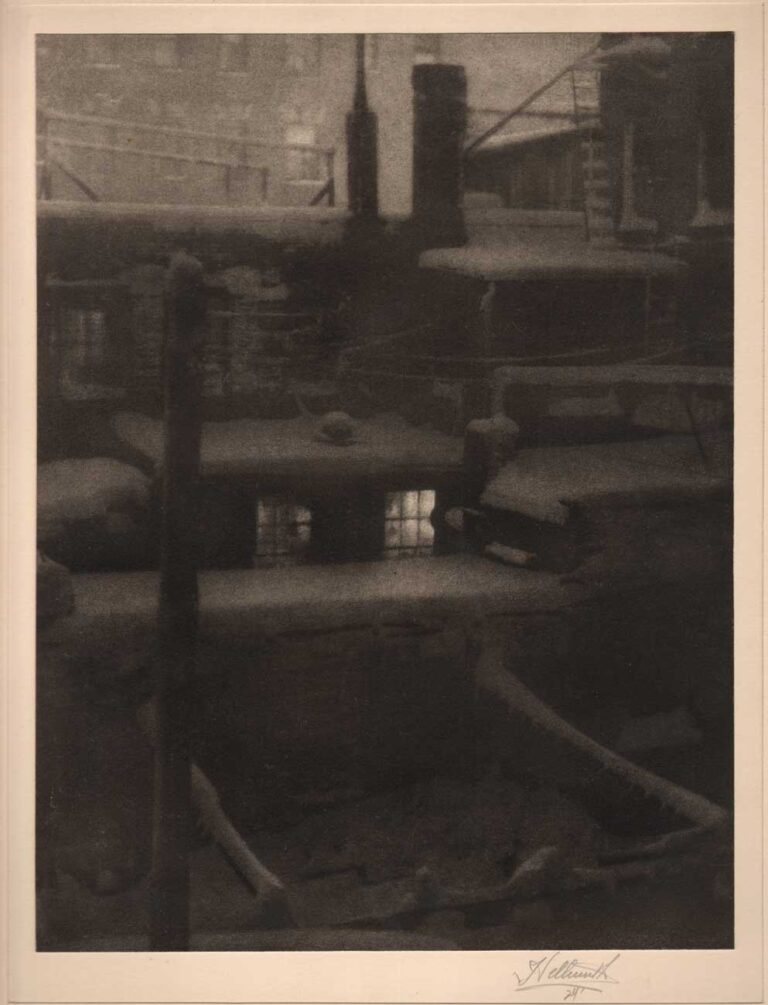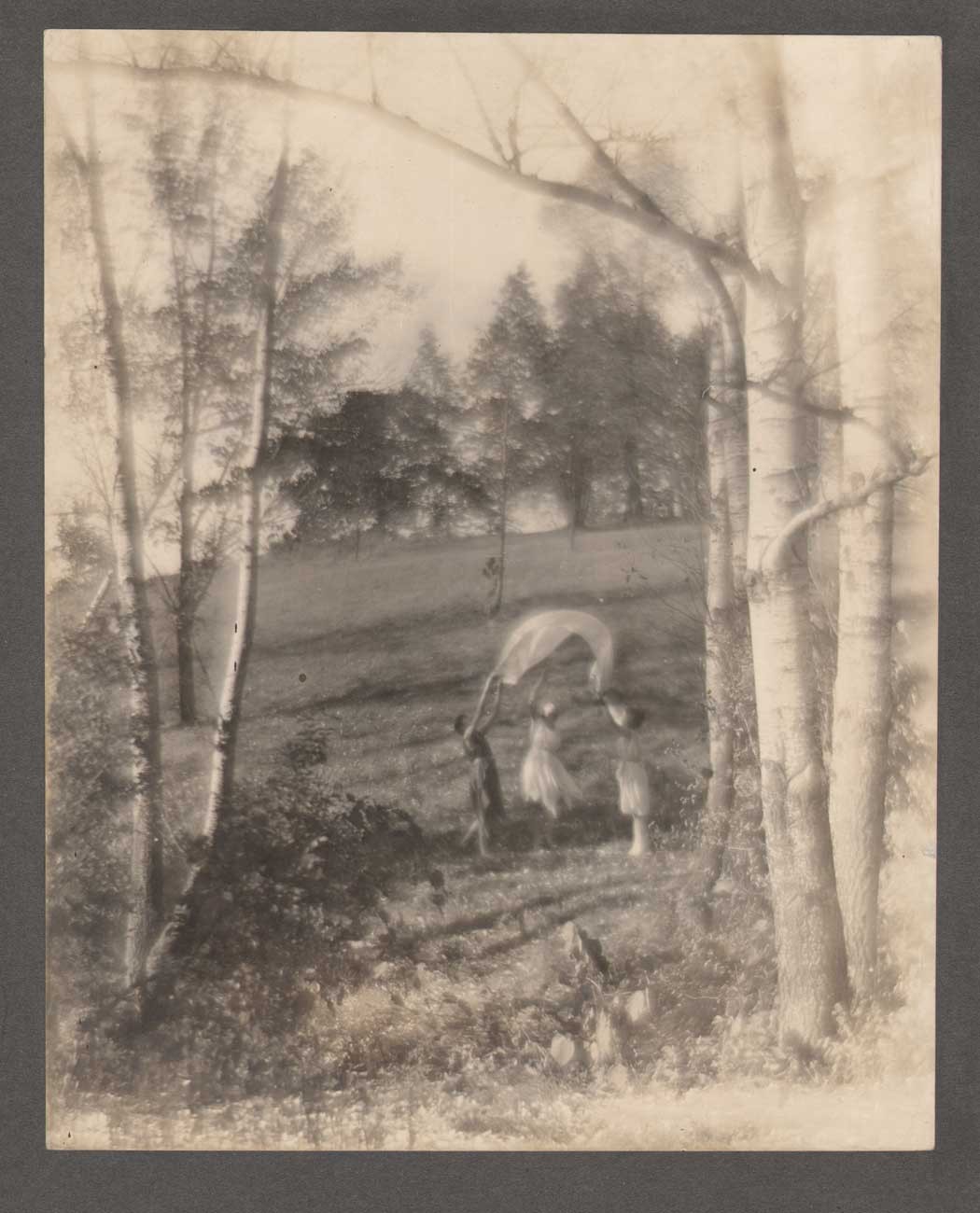
Interpretive Dancing Study
This untitled “Interpretive Dancing” study appeared as a full-page halftone with border drawing embellishment in the University of Wisconsin Badger yearbook for 1924. (p. 194)
George Clayton Bell, a professional photographer from Wisconsin whose style was decidedly pictorial during a career spanning in excess of 40 years: “Diffusion-not out of focus” was one such advertising mantra he used around 1920- was born on June 3, 1881 in Battle Creek, Michigan.
As an infant, he moved with his family to Elgin, Illinois where he later received his formal education at the Elgin Academy and Ballou Business College. (1.) Before being “taken into partnership” with his father Edward Bell in the cement and concrete business around 1900, (2.) an arrangement lasting less than a year, he said nearly 30 years later his first photographic apprenticeship commenced when he was only 14 years old in 1895 at Chicago’s Harrison Rad (sic) Studio. (3.) From 1897 he continued his photographic studies-probably through correspondence- at the Illinois College of Photography, where he “worked six winters learning the photograph business.” (4.) Driven, even while still taking courses, he went into business for himself in 1898 in Muskegon, Michigan, (5.) when he was around 17. The following extensive biography of George Clayton Bell appeared in 1924 after he had sold his successful Madison, Wisconsin studio the year before: one he had operated five years before heading for greener pastures in the big city of Milwaukee, WI:
GEORGE CLAYTON BELL.
During the five years that George Clayton Bell conducted a photographer’s studio in Madison, he won a well-merited reputation as an artist of marked ability, and he is continuing his good work in Milwaukee. He makes a special study of character portraiture, in which he is successful to a high degree, his pictures having good composition and posing, as well as fidelity to the personality of the subject. When Mr. Bell went to Madison he had already had a wide experience in his art, which he had first taken up as a boyish hobby when he was about fourteen years old. He was born on the 3d of June, 1881, at Battle Creek, Michigan, son of Edward and Mary Bell. His father, who was born in 1846 and died in 1911, was a native of the Isle of Man and came to the United States alone at the age of nineteen, having previously taught school in England for two years.
He lived at BattleCreek for a time, then moved to Elgin, Illinois, in 1881, where he was engaged in paving contracting business. The possibilities of Florida as a winter resort early attracted his attention and he was one of the group of men who founded St. Petersburg, which now has a nation- wide reputation as a delightful place in which to spend the winter months. In the later years of his life he owned a considerable amount of valuable real estate there. The paternal grandfather, William Bell, was a sea captain and owned a fleet of fishing boats that put out from the Isle of Man. Mr. Bell’s mother is still living and makes her home in Chicago. George C. Bell was taken to Elgin by his parents when he was less than a year old and there he grew to manhood, attending the public schools and completing his education at the Elgin Academy. Like most boys he became interested in photography when he was about preparatory school age, but with him it proved to be more than a passing hobby. His results were surprisingly successful for a lad of his age and he found an untiring delight in planning pictures with a view to obtaining lighting effects, artistic composition and good likenesses.
Meanwhile photography, which had been but little past the experimental stage in the early ’90s was rapidly gaining recognition as a permanent branch of art and profession in itself. Processes were being perfected and the results becoming more and more certain and satisfactory to amateur and professional alike. It was only natural, therefore, that this young amateur should turn, his hobby into a permanent occupation.
Going to Chicago to obtain some practical professional training, Mr. Bell entered the studio of Harrison & Coover, where he learned all that he could learn in this place. In 1898 he went into business for himself at Muskegon, Michigan, and remained there for two years. At the end of this time he returned to Elgin to go into business with his father, but his interest did not lie in the work of a contractor and at the end of a year he returned to photography. For a number of years he worked along this line in various places, spent four years studying art at Evansville, Ind., and later established studios in Grinnell and Newton, Iowa, which he maintained contemporaneously. In 1918 he sold these studios to go to Madison, where he was located at No. 509 State street.
On February 10, 1923, Mr. Bell sold his studio in Madison, and after a trip to the east he bought a fine residential studio in the heart of Milwaukee’s exclusive east side residential section. This is the so-called “Gold Coast” of Milwaukee. Here he caters to people of refinement and culture. His son, Sylvan Emerson Bell, is now in the studio with him and is assisting him in all branches of the work, besides acting as business manager. He formerly attended the University of Wisconsin, and is a member of the Paul Revere Chapter, Order of De Molay. As has already been stated Mr. Bell’s special line of work is that of character portraiture. The secret of his success lies in the fact that he is essentially an artist. He studies the personality and features of his subjects with the same care that a portrait painter bestows upon his work and to this he adds a fine feeling for composition and design that enables him to pose his figures with unusual grace and ease.
On the 25th of September, 1901, Mr. Bell was united in marriage
to Miss Ethel Anderson, daughter of Andrew Anderson, a jewelry
merchant of Rockford, Illinois. Mr. and Mrs. Bell have one child: A son named Sylvan Emerson Bell, whose birth occurred on August
23, 1903.
Mr. Bell is a Mason, belonging to Madison Lodge, No. 5, A. F. &
A. M. In joining this fraternal order he was doubtless influenced by
the example of his father, who was a stanch Mason and had attained
the thirty-second degree in the Scottish Rite. Politically George C.
Bell follows an independent course, taking no active part in the party
contests. He is a member of the Madison Association of Commerce
and in connection with his profession belongs to the National Association of Photographers. Mr. Bell has always been a lover of outdoor
sports and at one time played on professional teams, both in baseball
and football. His chief outdoor hobby is fishing, in which he takes
much pleasure, looking forward all winter to the time he can spend
at his summer home, where fishing tackle and bait form the principal
interest in the daily program. It is not surprising that Mr. Bell should
be a lover of all forms of art in the visual field of expression. One
would expect him to be something of a critic of painting, architecture
and sculpture, but it is a revealing sidelight on his personality to
discover that he is a lover and patron of music to whom the supporters
of this form of art may look for an appreciative and generous assistance in extending this phase of cultural life in Madison. (6.)
Select Professional Timeline: George Clayton Bell
1897: mention in Jan. 1916 Camera Craft magazine that Bell had been a student in 1897 at the Illinois College of Photography: “George C. Bell, a student of the I. C. P. in 1897, was winner of one of the first prizes at the last Northwestern Convention. Mr. Bell also achieved the highest score in the State of Iowa, at Des Moines last spring.” (p. 42)
1916: studio maintained in Newton, Iowa
1917: mention in Dec. 5, 1917 issue of Bulletin of Photography that Bell had just opened a new studio in Grinnell, Iowa (p. 580)
1918: Establishes a studio at 509 State St. in Madison, WI. Besides commercial portraiture, photographs a series of “Interpretive dancing” studies published in the University of Wisconsin Badger yearbooks from 1922-1925.
1919: Nine, full-page halftone pictorial portraits by Bell are published in the Kodak trade journal Studio Light in the July issue. The editors write:
“We think, however, you will agree with us when we say that the work of Mr. Bell is excellent. The soft lines, well-modulated shadows and opalescent highlights possess a quality you can readily appreciate. Such pictures appeal to your imagination. They have a peculiar beauty that can be secured in no other way.
Mr. Bell tells us that he does not make any negatives that are perfectly sharp. He also adds that this is not especially because he himself objects to sharp definition, but because his patrons almost invariably prefer the soft focus work, and it is only natural that he should give them what they want. He has made a reputation on such work, and his business is with the best class of people in his community.” (7.)
1920: advertisement for Bell’s studio appears in: Who’s Who at Wisconsin: Vol. 1: 1916-1921: p. 175:
THERE IS is a wrong way and a right way to decide how YOUR portrait should be made.
Ask for a sharp (microscopic) picture and you will get the old method used since photography was discovered, and you will be disappointed.
But ask for diffusion (not out of focus) and you will have the modern method of portraiture and you will be pleased.
Diffusion is a science not mechanical, and will produce that something in your portrait that will please you-that lives-your sub-conscious self.
Bell Master Portraits Are Different
Thinking people demand more than just a photo-a Portrait.
Geo. C. Bell, Artist-Photographer
19 West Main Street (Madison, WI)
1923: Sells Madison studio on Feb. 10, moving to Milwaukee, WI where he establishes another studio catering to wealthy patrons.
1942: working at Sturtz Studio in Green Bay, WI. (source: WWII draft registration record)
Interpretive Dancing at the University of Wisconsin
An apparently “truer form” of dancing than the “old aesthetic type” was how Interpretive Dancing was defined, at least by one member of the Alpha Chi Omega fraternity at the University of Wisconsin at Madison, where the dance form debuted in 1917. A department of the Women’s Athletic Association, the article Interpretive Dancing appeared in the group’s July, 1919 magazine: The Lyre of Alpha Chi Omega:
Interpretive Dancing at Wisconsin
The University of Wisconsin is proud of the fact that it is one of the few western universities to have a dancing studio in the Physical Education Department. We girls of Kappa are particularly proud because it is through the untiring efforts and under the guidance of Miss Margaret H’Doubler, one of our alumnae, that the studio has been possible.
Miss H’Doubler, for many years, was head of basketball at the university. Miss Trilling, head of the Physical Education Department, realized that there was need here for some truer form of dancing than the old aesthetic type which was being used. So Miss H’Doubler studied for a year in the East, visiting Chalif’s and other well-known schools of dancing. At last, with the aid of Miss Bentley, a teacher of music, a new form of dancing was worked out, and Miss H’Doubler returned in 1917 to present it to the women of the university.
The dancing is based on fundamental movements. The instinctive movements of running, jumping, skipping, and leaping are combined in a variety of ways depending upon the rhythm of the music and the time values of the notes. Pitch is also studied and worked out by the pupils. The work begins with relaxation, then goes on to crawls on the floor, and to spiral movements in the horizontal position. The object is to gain power in the use of all muscles, that is, to find oneself. Then the same movements are worked out in the upright position, and much is left to the individual’s own interpretation. The results are surprising.
The work was first started in an ordinary gymnasium. The normal students, those majoring in physical education, wear brown costumes, short and sleeveless, and sandals. The college girls wear costumes of delicate shades of blue, pink, and green. Miss H’Doubler wanted nothing artificial about the room, for the work was to be sincere, straight from within and depending upon one’s own power and appreciation. The dancing classes immediately became popular and the enrollment nearly doubled.
This year the room has been hung with soft gray curtains, and is lighted with rose-shaded lamps. The daily class work is not open to the public, but a series of recitals is given on Friday afternoons. No wonder that this dancing has become so popular for it lends grace of bearing along with the feeling of power and control, and it teaches us to use our bodies most effectively.
Louise Sammons, Kappa. (8.)
print notes: unsigned and dating to perhaps 1923, the image margins have faded with possible camera “pin registration” holes punched through outer corners of cardboard support. These may have been used during publishing requirements of yearbook.
Notes:
1. George C. Bell: from: The Historical Encyclopedia of Illinois and History of Kane County: vol. II: Chicago: 1904: p. 740
2. Ibid
3. Advertisement: “George Clayton Bell Student of Portraiture“: in: The Milwaukee Sentinel: Nov. 11, 1929: The actual name for the studio he apprenticed at was the Harrison & Coover Studio in Chicago
4. George C. Bell: from: The Historical Encyclopedia of Illinois and History of Kane County: vol. II: Chicago: 1904: p. 740
5. George Clayton Bell: Wisconsin, Its History and Its People, 1634-1924: 1924: Chicago: The S.J. Clarke Publishing Company: pp. 609-611
6. Ibid
7. A Word about Our Illustrations: in: Studio Light: Incorporating The Aristo Eagle – The Artura Bulletin: Rochester: The Eastman Kodak Company: June, 1919: p. 12. The entire article including pagination for illustrations runs pp. 5-14
8. “Interpretive Dancing at Wisconsin” from: The Lyre of Alpha Chi Omega: published by George Banta: Menasha, WI: July, 1919: p. 276
